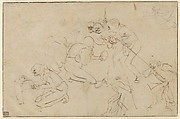Studies for an Adoration of the Shepherds
Adriaen Brouwer Flemish
Not on view
Although no such picture by his hand survives, Brouwer, on this working sheet, explored solutions for an Adoration of the Shepherds. Lively figure studies in black chalk, some of them reworked in pen and ink, cover the page. Occupying the middle part of the sheet is a rendering of the entire figural group. At its center is the Christ Child; his profile is summarily indicated with a few quick pen strokes, which overlap with two diagonal lines—the leg of one of the shepherds—and two horizontal strokes—the top of the cradle. Gazing down at the infant are three crouching figures, one of whom holds a staff and a candle. Two other heads, left only roughly indicated in black chalk, appear to the left of this trio. Below them, another man kneels before the cradle, his right hand raised in a gesture of awe. To his left, the bulky form of an ox can be discerned. At lower right, Brouwer drew two additional versions of the stooped man with the candle, trying out different arrangements of the legs, arms, and staff. He also considered, with the sketches in the upper right and lower left corners, a kneeling figure in profile, facing left, with the Christ Child repositioned accordingly. Finally, at upper left, a man with a hat sits with his back toward the viewer, his head turned to the left.
While many artists portrayed the shepherds who came to adore the newborn Christ as unidealized and suitably rustic figures and, increasingly in the late sixteenth and early seventeenth centuries, as decidedly "low" types, Brouwer’s shepherds—with the same ungainly poses, pointy chins, and beady eyes as the drinkers and smokers in his tavern scenes—are especially striking. As a subject, the Adoration of the Shepherds may have appealed to him as a occasion to deploy such figures beyond the genre in which he usually worked.
(JSS, 8/23/2018)
Due to rights restrictions, this image cannot be enlarged, viewed at full screen, or downloaded.



